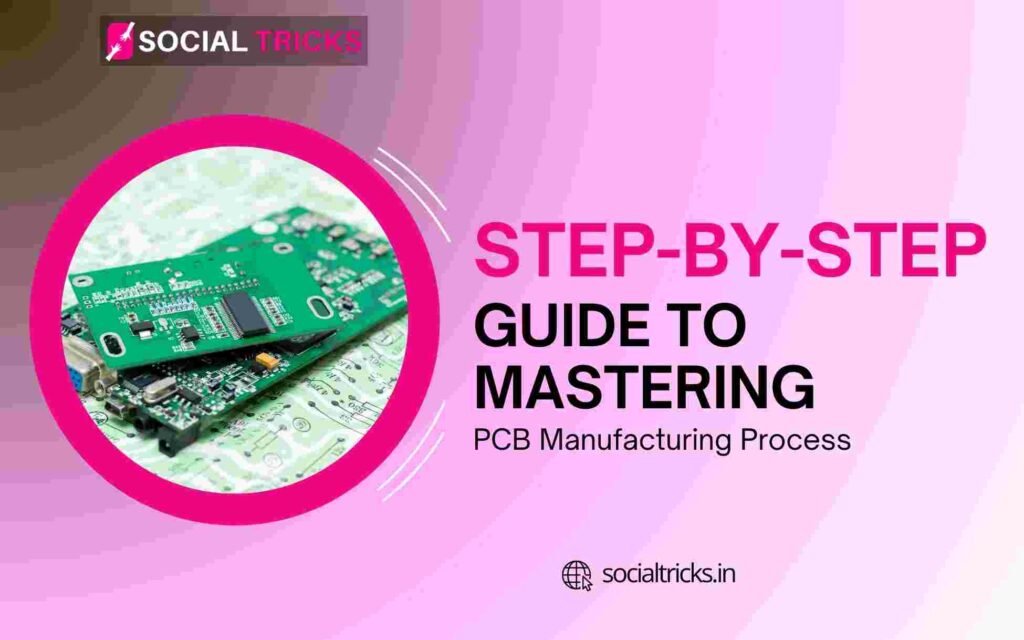Printed circuit boards are perhaps the most important components of all electronic devices. They provide Printed circuit boards are perhaps the most important components of all electronic devices. They provide a medium between the components and enable electricity to flow. Once you know how to manufacture PCBs, you will understand the foundation of modern electronics. Here is a simple step after another and a guide to mastering PCB manufacturing in such a way that even a 10-year-old could understand it.
What is a PCB?
A printed circuit board is a thin, flat board, generally made by materials such as fiberglass, plastic, or metal, with copper lines on it acting as a highway for electricity to travel and link components such as resistors, capacitors, and microchips. You can find PCBs in devices like smartphones, computers, and, well, in some cases around washing machines.
PCB Materials
- Substrate Material: It is the base material of PCB which is made up of glass fiber, sometimes epoxy resin, etc.
- Copper: it is used to make the conductive paths.
- Solder Mask: It is the green or other colored coating covering the copper.
- Silkscreen: It is meant for marking components on the PCB.
Step 1: Designing The PCB
What happens?
Each PCB technically starts with a design that engineers can do using the tube-fed software design like Eagle, Altium, or KiCad. The design elements include:
- Copper pathways (traces) themselves.
- The place for the components like resistors or LEDs.
- Mounting holes.
Why is it Important:
It is this stage that ensures that the PCB operates properly in the device where it is to be used.
Step 2: Printing the Design on the PCB
What Happens?
The design is now printed into the PCB material with the copper pathways having been transferred to the board using photoresist imaging.
How is it Done?
- Application of a special light-sensitive photoresist.
- UV exposure of the design onto the board.
- Rinsed away unexposed areas will finally give the copper pathways.
Step 3: Etching the Board
What Happens?
Only the copper traces from the design remain after removing the undesirable copper.
How is it Done?
- Dip the board into the chemical solutions) usually ferric chloride.
- It is ingested by the solution while copper is still there.
Fun Fact:
It is very much like carving pictures into a block of marble, but here using chemicals and copper! Would you mind explaining stepwise?
Step 4: Adding Solder Mask
What Happened?
A layer is plated by the solder mask. A coating avoids solder going to unintended spots which in turn prevents short circuits.
Why Green Actually?
Commonly, green is used for the solder mask since it gives an impression to the eyes when inspecting. However, other colors such as red, blue, or black can be painted.
Step 5: Silkscreen Application
What Happened?
This is when labels are printed on the PCB. It helps to identify where to put components during the assembly process.
How is That Done?
By printing their text and symbols using a special ink onto the board through a special screen.
Step 6: Perforation of Holes
What Really Happens?
Holes are drilled small in the PCB for mounting components, such as capacitors and resistors.
How is it Done?
Computerized drill forms exact holes. Drill bits as thin as a strand of hair are used for micro-sized holes.
Cool Fact
With today’s technology, thousands of holes can be drilled in a matter of minutes!
Step 7: Plating the Board
What Happens?
The holes drilled are plated with a thin layer of metal, mostly copper. This ensures that the hole has electricity flowing.
Process:
Submerging the board inside a chemical bath. Metal adheres to the inside of the holes.
Step 8 : Checking the PCB
What Occurs?
The PCB is then thoroughly tested before being sent for assembly.
How is it Done?
- Electrical Testing: Checks open circuits (breaks) and short circuits (unwanted connections).
- Visual Inspection: Ensures correct fitment and placement of all parts and pathways.
Step 9: Assembly
What Happens?
Components are placed and solder onto the PCB. The soldering resembles gluing parts to the board; it uses melted metal.
Methods employed:
- Manual Soldering: For small-scale or prototype boards.
- Automated Assembly: Machines place and solder components for large-scale production.
Step 10: Last Quality Check
What Happens?
There is a final inspection for the PCB that confirms if it has any defects. It includes:
- The device part testing.
- Visual inspection of damage.
Some Statistics
- PCB Global Market Value: Estimated to be around $86 billion by 2027.
- PCB Thickness: Most often consists of 1.6 mm, but can otherwise be tailored for specific applications.
- Drilled Hole Size: Microholes can be as small as 0.1 mm.
Why PCB Manufacturing is Important?
- For the Electronics Industry: the backbone of technology.
- For Innovation: it would enable devices to be created to become smaller, faster, and uses less energy and resources.
- For Everyday Life: TVs, toys; PCBs are everywhere!
Some Challenges Faced by PCB Manufacturing
- Alignment Issues: The traces have to be aligned to that of the components.
- Over Etching: Removing too much copper.
- Thermal Stress: The boards can warp under excessive thermal conditions.
The successful ways in solving those challenges:
- Use high-quality materials.
- Regularly calibrate machines.
- Thorough testing.
Conclusion
Mastering the PCB manufacturing process is a must for almost anyone into technology. Knowing every step-from design to testing-certainly brings you to understand how hard it is to create a modern electronic device. Whether a novice or aspiring engineer, this guide is the ground base you need to dig further into the exciting world of PCBs. Remember, every great gadget starts from a small but mighty PCB!


